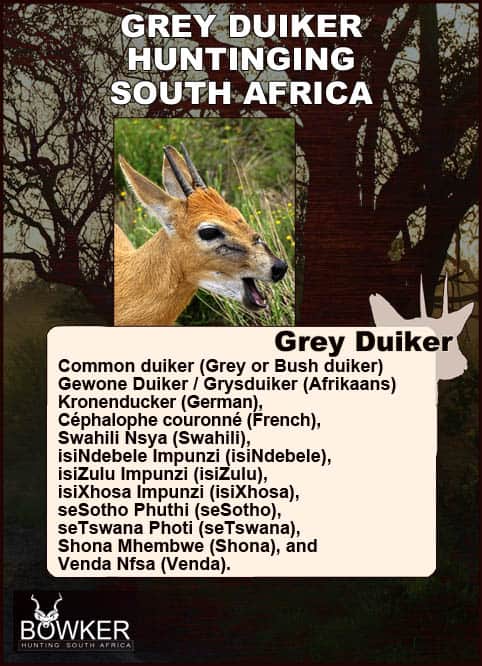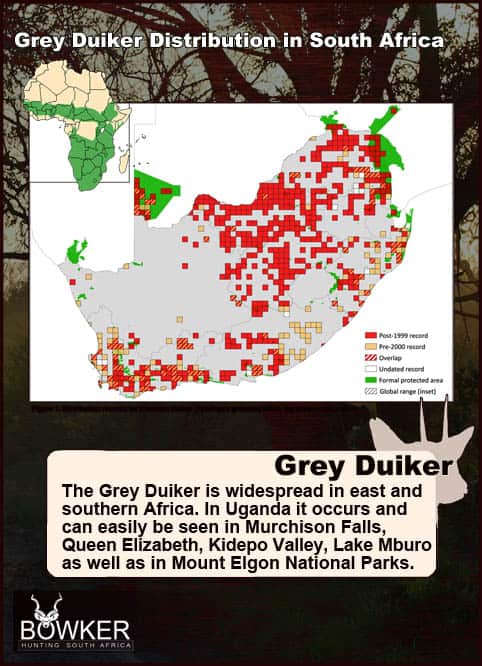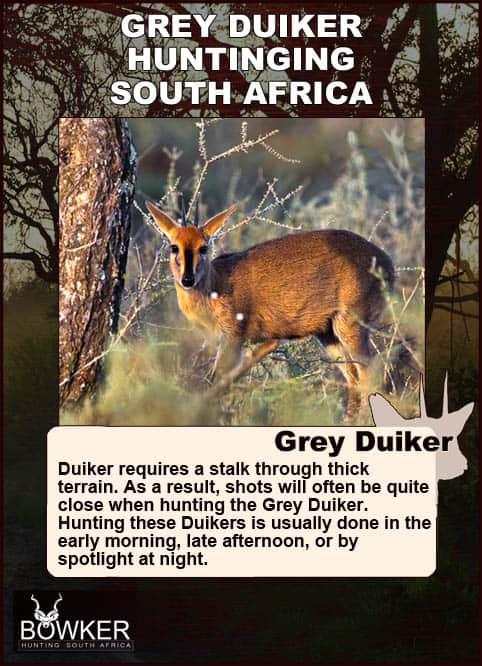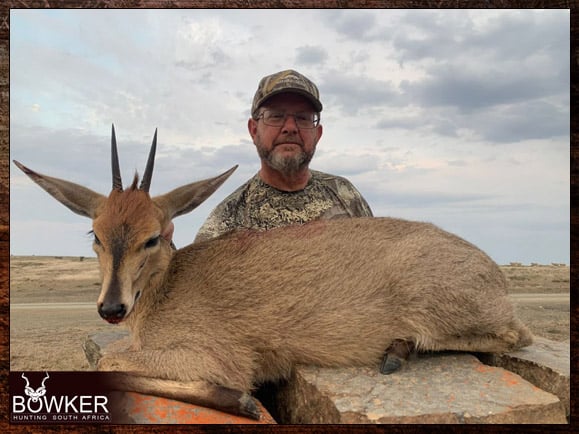
Summary
Grey Duiker hunting or common Duiker is often opportunistic while glassing for other trophies.
Consequently, they can make for a bonus while looking for your bigger game animals.
A Duiker requires a stalk through thick terrain similar to a bushbuck.
As a result, shots will often be quite close when hunting the grey duiker.
There are no seasonal restrictions on the Grey Duiker trophy in Eastern Cape, South Africa.
Nick Bowker Hunting offers Trophy Duiker game hunting in Africa year-round.
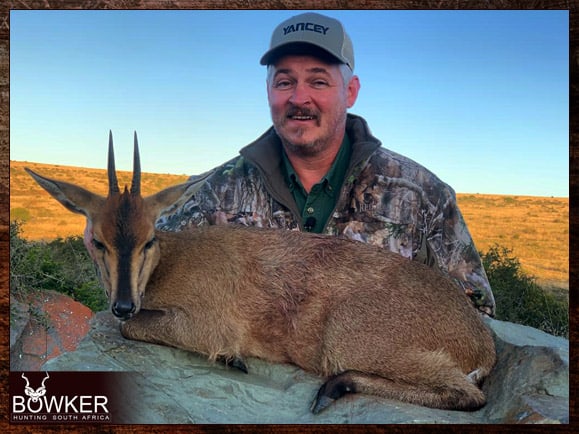
Table of Contents
Grey Duiker Trophy Fees in South Africa – 2025
The average price of a duiker is around $200. The Grey Duiker can be added to our hunt packages and is one of the cheapest hunts in South Africa.
Our 2025 Grey Duiker price is $200.
The Grey Duiker trophy hunting package includes a licensed hunting guide, a hunting license, and all permits.
Grey Duiker Hunting in South Africa
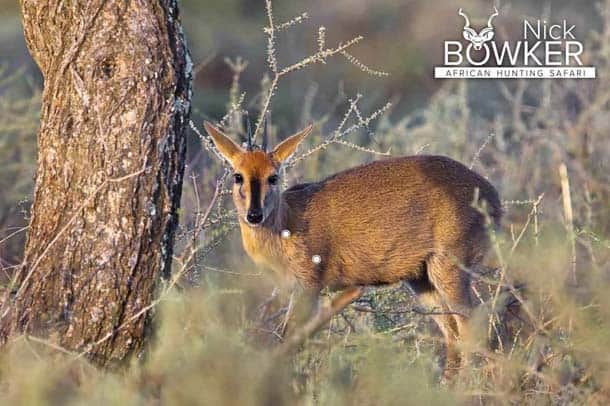
Shot placement must be in the bottom third of the animal directly above the front shoulder. This will ensure a heart or lung shot. Avoid head and neck shots, which are high-risk for hunting Blue Wildebeest.
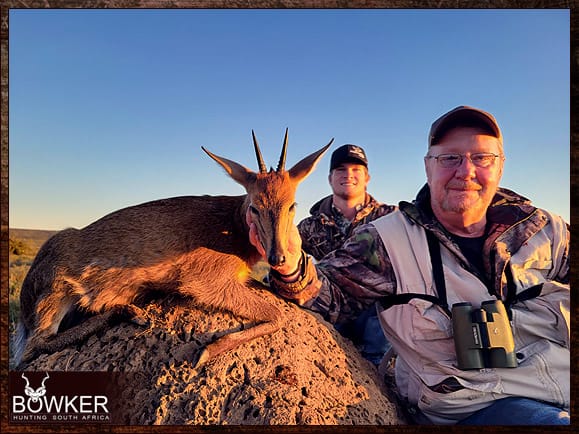
Your Duiker trophy should have an average shoulder height of around 17 inches, weigh about 25 pounds, and have a Horn length of approximately 4 inches.
The minimum Safari Club International score for a Duiker is 11. They are measured by adding the length of each horn as well as the circumference of the bases.
Duikers are solitary animals and often shot opportunistically while glassing for big game trophies.
They can make for a bonus while looking for your bigger game animals.
Duiker hunts require a stalk through thick habitat and terrain. As a result, shots will often be quite close when hunting grey duikers.
Shooting Duikers is usually done in the early morning, late afternoon, or by spotlight at night.
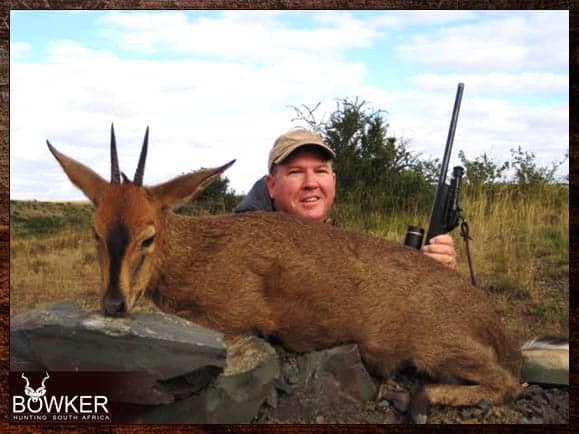
The Duiker forms part of the Tiny 10, and hunting one is a must for any hunter wishing to complete their selection of the small antelope species.
The duiker is primarily a browser and is most active during the late afternoon and early evening.
This member of the pygmy antelope clan can survive close to man.
He is independent of water as he can get sufficient moisture from browsing.
Common Duiker Hunting makes a cheap add-on to our seven animal hunting packages, including trophies as kudu and blesbok as standard.
A more expensive addition would, say, be a common reedbuck.
We do not require a deposit; please review our terms and conditions for any hunting safaris.
Trophy Judgement and Rifle Caliber for Hunting Duiker
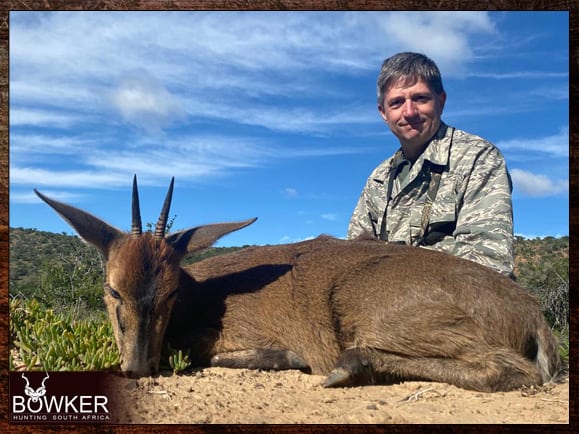
Trophy Duiker evaluation can be difficult when hunting a duiker, as only fleeting glances will be offered.
Horn tips that are level with the top of the ears are about 4 inches long; if the horns extend beyond the ear tips by an inch or more, you are looking at a high-scoring trophy.
Duiker hunting can be challenging; this mini-antelope has remarkably refined senses, small size, camouflaged coloring, and a habit of staying in or close to the long grass and thick brush.
Most hunting calibers are used to take the duiker as it is often opportunistic. However, if targeting – hunt Duiker with a 243.

For those hunters who do not wish to go through the red tape of bringing a rifle into South Africa, Nick Bowker has a Sako carbon light 243 fitted with a Swarovski Z8 tactical scope.
Also, we use Sako factory ammunition for duiker hunting.
Shoot straight up for the leg, as with all African mammals, for the heart-lung shot.
The Duiker or bush Duiker makes for a very underrated plains game hunting. Duiker hunting is a favorite pastime amongst local South Africans during hunting season. Hunting methods amongst the locals mainly involve driven hunts.
The Difference between a Male and Female Grey Duiker for the Hunter
Grey Duiker males have horns, while females do not. The female and the male have a tuft of hair growing on their heads.

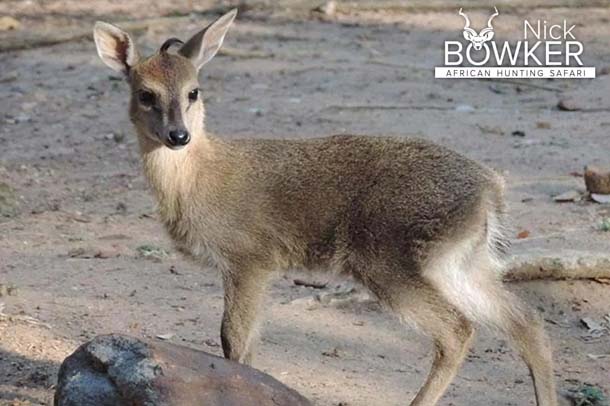
Interesting facts About the Duiker for Hunts
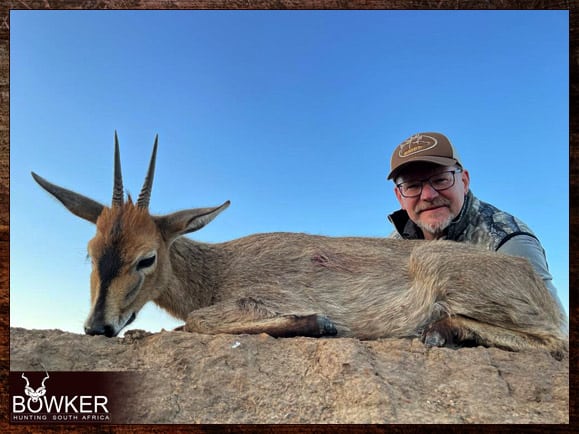
- The common duiker will stand on its hind feet to reach high into fruiting bushes.
- There are eight different races of common duiker. This varied coloration may enable them to match the habitats specific to their location.
- Some African rock pythons have died when the horns of male duikers have pierced their stomachs after they have swallowed them whole.
- When they flee danger, Duikers run with a distinctive darting and diving style. This gives rise to its common name, the Afrikaans for diver.
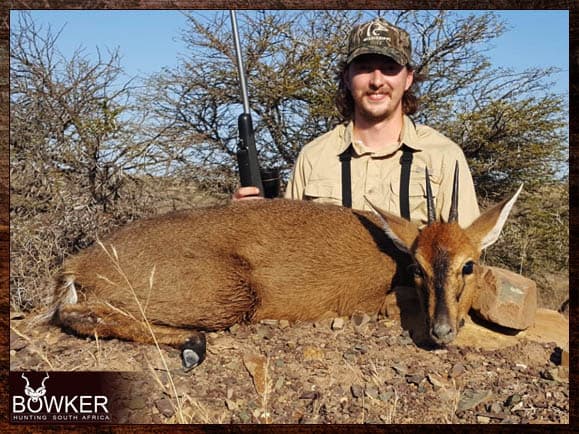
- Not a lot is known about the common duikers’ social life, so more research is needed before we can say whether they are monogamous and territorial.
- While duikers predominantly eat leaves, some unusual items have been found in their diet, including baby birds and small rodents.
- It’s not known whether these are eaten by accident or as a protein supplement.
- The common duiker uses a pair of glands under its eyes for scent marking.
- Duiker hunting often occurs while glassing for other trophies and can make for a bonus while hunting larger trophies.
About the Grey Duiker Antelope
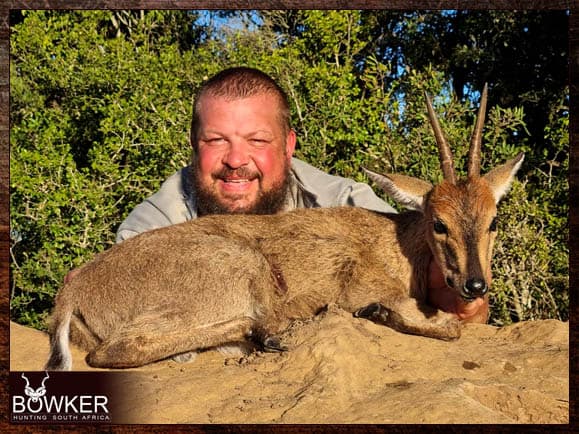
Duiker is a small to medium-sized brown antelope native to Sub-Saharan Africa.
Found in heavily wooded areas.
Duikers are shy, elusive creatures and live in dense cover; those that tend to live in more open areas, for example, quickly disappear into thickets for protection.
Duiker hunting is often underestimated mainly because of the size of the animal.
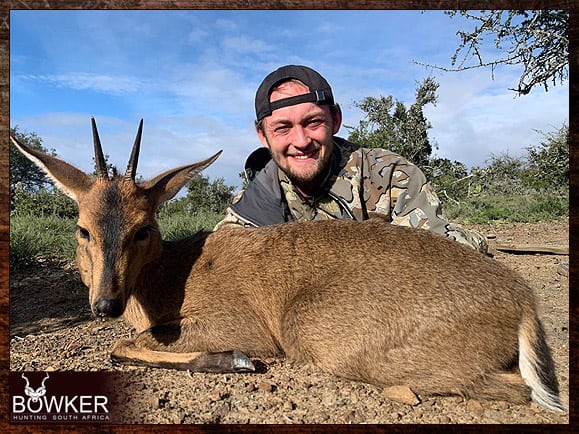
Since the common grey duiker lives in more open areas, like the savanna, it has longer legs and vertical horns, which allows it to run faster and for longer distances; only the males, who are more aggressive and territorial, exhibit horns.
Also, duikers have well-developed periorbital glands, which resemble slits under their eyes or, in the cases of blue duikers, pedal glands on their hooves.
Males use secretions from these glands to mark their territory.

Frequently Asked Questions About Trophy Duiker Hunting
How much does it cost to hunt a Grey Duiker?

The trophy fee for a standalone Grey Duiker hunt is between $250 and $300.
Daily rates vary between $250 and $500 per day.
Included in the Grey Duiker trophy fee is a licensed guide. As well as a hunting license and all permits.
How to hunt a Grey Duiker?

Grey Duiker hunting is in the early mornings and late evenings and spotted from an elevated vantage point in the thick brush and then stalked. Alternatively, hunters use ambush techniques at watering holes or as they move back to cover from feeding.
Grey Duiker are often hunted by sitting in a vantage point in the late evening and waiting for the Grey Duiker to step into small fields and begin grazing.
Where do you shoot a Grey Duiker?

Shot placement must be in the bottom third of the animal directly above the front shoulder. This will ensure a heart or lung shot. Avoid head and neck shots, which are high-risk.
What is a trophy, Grey Duiker?

Grey Duiker trophies have a Horn Length of approximately 4 inches. The minimum qualification score under Safari Club International for a Grey Duiker is 11. Add the length of each horn and the circumference of the bases to get your SCI score.
How do you judge a Grey Duiker trophy?

Horn tips that are level with the top of the ears are about 4 inches long; if the horns extend beyond the ear tips by an inch or more, you are looking at a high-scoring trophy.
Seasonal Restrictions for Duiker Hunting
When can you hunt Grey Duiker in South Africa?

There are no seasonal restrictions on Grey Duiker hunting in designated conservancies in the Eastern Cape of South Africa.
What Caliber is Recommended for Grey Duiker hunts?

Most hunting calibers are used to take the duiker as it is often opportunistic. However, if targeting a Duiker, we would recommend a 243.
The Common Duiker in Pictures for Game Hunting
